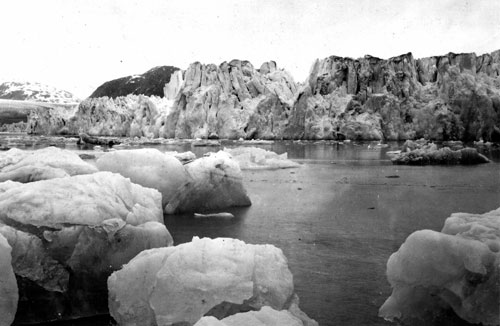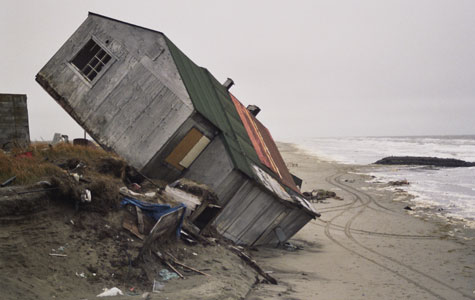Future Geographies: The Evidence for Climate Change
It is clear from past research that Earth's climate has varied significantly over time, the causes of which are many and complex. Even over the span of human history, the Earth has undergone significant periods of warming and cooling. Present day global warming however is not, to most scientists, a consequence of natural climate variability. Most recognize that the present change to a warmer climate is a product of human impact on the Earth system.
Watch "Global Warming" Courtesy of NASA
Evidence for Global Warming
Though a few scientists remain skeptical, there is a a growing consensus that the present day warming is real and humans are driving it. Evidence for global warming can be found in every part of the Earth system. Besides well documented changes in air temperature, global warming is
- heating the world's oceans
- reducing sea ice extent, especially in the Arctic
- melting glaciers
- causing sea level to rise
- altering habitats and,
- affecting plant and animal distributions
Evidence from the oceans
Global warming has already had a significant impact on the hydrosphere, especially glaciers and oceans. Tide gauge measurements show a worldwide increase of sea level of 15-20 cm (6-8 inches). According to the Intergovernmental Panel on Climate Change (IPCC) suggest the rise is due to the expansion of ocean water due to rising temperatures (contributing about 3 - 7 cm) and the melting of mountain glaciers and small ice caps (contributing about 2 - 4 cm). Sea level is rising so high in locations like the arctic coast of Canada that small villages are threatened.
A 2005 study provided "compelling" evidence that ocean warming over the past 40 years is linked to the industrial release of carbon dioxide. Scientists from Scripps Institution of Oceanography used a variety of scenarios to reproduce the observed rise of ocean temperatures over the last four decades. The rise of ocean temperatures could not be accurately explained by computer models based on the natural climate variability of solar radiation and volcanic emissions. "What absolutely nailed it was greenhouse warming," said Dr Barnett, lead scientist on the study. Their model reproduced the observed ocean temperatures with a statistical confidence of 95%.
Arctic sea ice has experienced a significant decrease in areal extent over the past few decades. Recent NASA research indicates that arctic sea ice is shrinking at a rate of 9.6 percent per decade. September ice coverage between 2000-2005 were 20 percent below the period 1979 - 2000. Such ice thinning and retreat has impacts ocean salinity, heat balance and animal habitat. Polar bear populations are on the decline as ice thins making for precarious hunting conditions. Ice pack break up leaves polar bears stranded further from land. Polar bears are being forced to swim longer distances between ice floes and drowning during the journey.
Figure 9.46 Arctic Sea Ice, September 1979 to September 2014
(Courtesy NSIDC)
Evidence from glaciers
Evidence for warming is occurring in all parts of the Earth system. Most of the world's glaciers are in retreat as a result of global warming. Evidence for the loss of ice is documented in the journals of the first explorers to Alaska. In the 1790's travelers to the area near Glacier Bay reported only a small embayment of coastline with a large glacier occupying the basin of Glacier Bay. By the 1890's the glacier was in retreat as 40 miles of coastline was now exposed. Today, visitors can still marvel at the great tidewater glaciers, but for how long? Glacier Bay now extends for 60 miles.
Bruce Molinia of the United States Geological Survey has documented the retreat of Alaskan glaciers by comparing present day conditions to photographs taken by geologists and visitors to the region over a century before. The dramatic evidence is seen in photographs of Muir Glacier taken from the same position in 1899 and 2003.
|
|
Figure 9.47b Muir Glacier, 2003 |
The BBC's David Shukman reports that
scientists have found that the rate of melting on the Greenland ice cap
is far greater than what normally occurs during the summer.
Sea level is expected to rise by 7 meters should the ice cap melt,
drowning coastlines worldwide. A first ever gravity survey of Antarctica recently revealed that it had lost a substantial amount of mass. Researchers found that the ice sheet covering Antarctica lost 152 (plus or minus 80) cubic kilometers of ice annually between April 2002 and August 2005. The estimated mass loss was enough to raise global sea level about 1.2 millimeters (0.05 inches), about 13 percent of the overall observed sea level rise for the survey period. Video: Watch James Balog's TED Talks presentation about Evidence from plant and animal distributionsEvidence of global warming is appearing in the distribution of plant and animal species. Growing seasons in many parts of the globe have shifted as a result of warmer temperatures. Scientists have observed that plants have been slowly moving toward higher elevations in some mountain regions. This "escalator effect" as it has been called, has pushed some plant species up as much as ten feet (3 meters) in some mountain regions. Because some plant species migrate faster than others, established ecosystems could be severely altered.
Figure 9.49 Great Tit (Parus major) Source: Wikimedia Animal species are also responding to habitat changes as a result of global warming. As spring arrives earlier in the year, migrating animals start moving earlier in search of food sources. A recent study of the great tit (Parus major) reported that the birds are laying eggs nearly two weeks earlier than they have over the past fifty years. Doing so enables them to hatch earlier and take advantage of caterpillars which are also appearing two weeks earlier due to warmer spring temperatures.
Geographic Patterns of Global WarmingThe effects of global warming will not be the same in all places.
The smallest changes in temperature are to occur in tropical
regions, while the Arctic and Antarctic will experience considerable
changes. The Arctic regions are seen as the "bell weather" of what
global warming will bring. [ |
|


_1Wikimedia_small.jpg)

